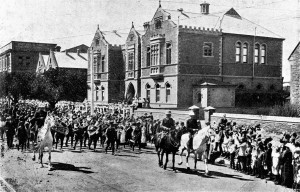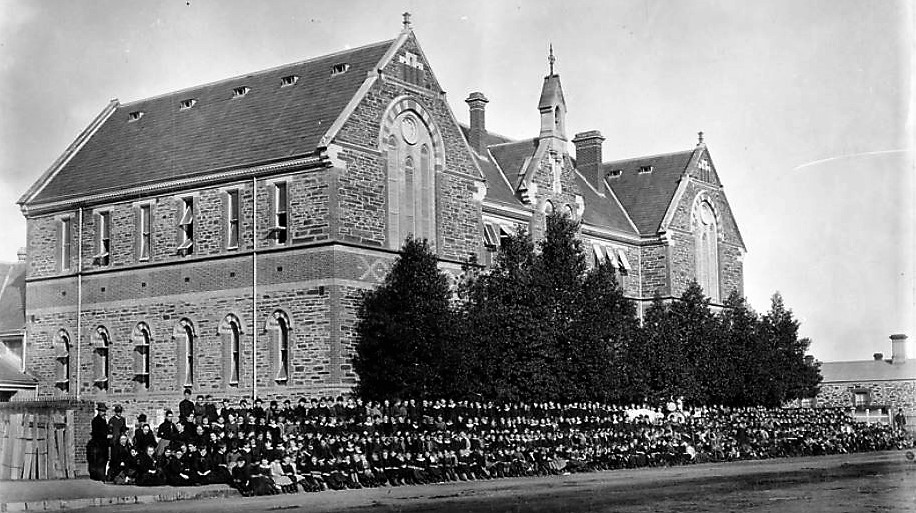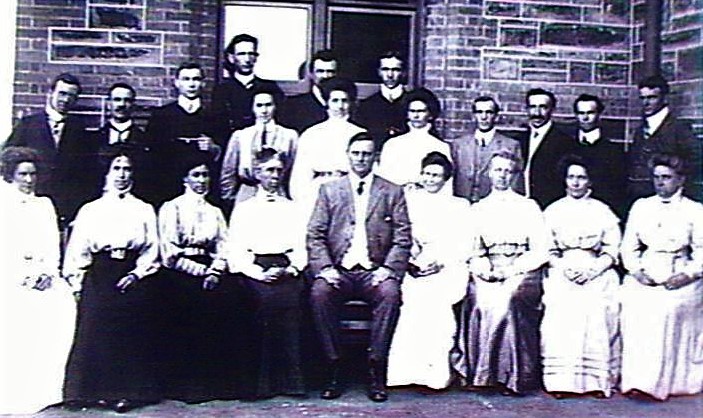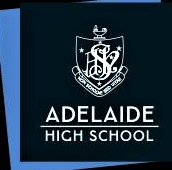The Education Act of 1875 in South Australia provided for the foundation of a system of public, mainly elementary schools. It also allowed “infant schools, evening schools, schools for the teaching of any branch of science or art, and advanced schools for continuing the education of scholars who shall have obtained prizes at public schools, or otherwise proved themselves qualified for admission: Provided that the course of training in all such schools shall be secular” (clause 12). Though a system of government high schools was barely imagined at the time, there being none in any of the Australian colonies, the provision for “advanced schools” for children who had proven their merit allowed the possibility for the future. When a South Australian government decided to establish its first coeducational high school in 1908 a remarkable effort was required to invent an institution that would pioneer new access to secondary schooling in the state.
Predecessor institutions and student populations
When Adelaide High School, the first free coeducational high school in South Australia, and according to some, the British Empire, was opened in 1908, it emerged from a group of predecessor institutions and student populations. Each contributed something in terms of culture, governance and mission. In tracing the reasons for the development of the predecessor institutions, the pre-history of government high schools in South Australia is also traced.
The Advanced School for Girls (1879-1908)
The Advanced School was founded mainly to provide opportunities for the higher education of women, in line with the University of Adelaide allowing the enrolment of and granting degrees to women in the 1870s. Although there were private schools of substance in Adelaide, collegiate church schools for girls were rare. Families in search of such institutions supported the idea of a state school for girls. The subsequent Advanced School for Girls was never particularly large, but it provided many of the first female graduates of the University of Adelaide. Its last principal, Madeline Rees George would transfer into Adelaide High as “headmistress”, but she would not be co-equal with the new headmaster.

Adelaide High in 1911. Buildings from far left to right: the predecessor schools: Advanced School for Girls, Pupil Teacher School, Grote Street Public School. State Library of SA, B 5814
Pupil Teacher School (1900-1908)
This school arose from the necessity to train public school teachers just prior to and following the Education Act of 1875. The older Grote Street Model School (1874), then Grote Street Training College (1876) were predecessor institutions to the Pupil Teacher School. The new Adelaide High School would retain a significant role in the educating of pupil teachers.
Continuation classes of Grote Street (Model) School and other public schools
Grote Street School was a mainly elementary school so most of its students did not transfer to the new Adelaide High. The high school occupied its buildings. From 1906 continuation classes at Grote Street and other nearby public schools began teaching a junior secondary curriculum. These students were transferred into the new high school.
State exhibitioners
Scholarships (exhibitions) had been available to support the attendance of meritorious boys and girls at select secondary colleges (boys to Prince Alfred’s College and the Collegiate School of St Peter and girls to the Advanced School for Girls). From 1908 the exhibitioners were required to attend the new Adelaide High School.
With these predecessor institutions and student populations the success of the new high school was assured. It did not grow from very little as had some of the 1880s high schools in New South Wales, some of which failed within a few years. The Adelaide High School, unlike those in New South Wales, enrolled both boys and girls from the start, adding strength to the institution. There had been an organic growth from the mission of the public schools and a clear place for the school in the preparation of future teachers in the public school system. In this, Adelaide High had a similar history to that of the new Melbourne Continuation, then High School, founded in 1905.
The foundation of a school such as Adelaide High had been opposed for many reasons over many years. (There never had been an Advanced School for Boys.) One of the major reasons for opposition was a belief by church collegiate and private secondary school owners and supporters that government high schools would compete too well for enrolments and examination success. The second reason was a belief that the secondary curriculum was unsuitable for working class boys and girls. Government schools were only justifiable for the lower classes and need not teach more than the elementary curriculum. During the first decade of the twentieth century these arguments had been undermined. The lead up to the Great War and the fears of the British Empire regarding its industrial and technological readiness led to a belief that more young people should receive a better and higher education, as a demand for more and better educated workers, technicians, managers and others was anticipated.
1908: Foundation
The school, situated in the west of the square mile of Adelaide, incorporated the buildings of the predecessor institutions. The school also signified the influence of the Director of Education, Alfred Williams, whose 1907 report to the South Australian government, had recommended the creation of government high schools for nation-building and economic reasons. Williams also imagined high schools as essential institutions for the education, care and training of adolescents, newly conceived as ‘at risk’ from too early an entry into labour markets and the adult world in general.
The newly appointed principal was William Adey. He governed the school from 1908 to 1920. His was a significant task. Not only did he need to bind the predecessor institutions together into one school, he had also to “invent” what such a school should be: how it was to be governed, how its available staff were to be disposed, how its culture should develop, and how to justify its establishment in the numerous ways that ‘success’ might be defined.
Governing South Australia’s first coeducational state high school
The Education Act of 1875 instituted a comprehensive system of state elementary schools. How they were to be governed was outlined in extensive regulations which were not always useful for the new high school. Issues that quickly caused problems were teacher staffing, school inspection and the powers of the principal as opposed to those of the State Education Department. The Education Act of 1915 and succeeding regulations would clarify many of the issues, but before then, negotiation, and sometimes conflict, settled urgent questions.
Question 1: Would the high school be inspected, and if so, what roles would inspectors play?
In the first few years some people, among them A.H. Peake, sometime premier of South Australia, thought that Adelaide High would develop into a state college, perhaps resembling the secular Sydney Grammar School (1857- ). If this was to occur, like the church collegiate schools such as Prince Alfred College, the school would not be inspected.
The Director of the Education Department believed that inspection was required and appointed Edward Jordan to inspect the high schools, but not exclusively. In 1910 and 1911 district high schools were also founded but they were inferior in rank to Adelaide High. When Jordan arrived at Adelaide High to inspect the school in 1911, Headmaster Adey prevented his entry. He argued that as Headmaster it was his responsibility to ensure the success of the school. No inspection was required. Nevertheless, the final determination was that Adelaide High would be inspected. The Education Department was unwilling to allow the growth of a semi-autonomous institution within its sphere of influence.
Question 2: Would the high school be governed and run like any other public school, an appendage of the much larger elementary school system?
The Education Department inspectorate believed that it would be many years before the high schools could be separated from its supervision and a close relationship with the elementary, now “primary” schools should continue indefinitely. The district high schools were founded as annexes of large, mainly primary, public schools. Most of the teachers in the new high schools had been elementary school teachers. Eventually the South Australian government determined that there needed to be a separate “secondary branch” in the Education Department.
Alfred Williams’ report of 1907 had implied, and sometimes directly argued, that the high schools were to have a very specific role to play in youth management and training, and in economic development. The high schools would provide a more accessible path to higher education. If the high schools were to be respected in broader South Australian society, they needed to build a distinctive culture among their staff and students, different from the elementary schools. Most members of the existing inspectorate may have accepted the argument in theory but were reluctant to give up their power over these new institutions in the expanding public education system.
The 1915 Education Act separated the district high schools from the public schools to which they were annexed. Adelaide High joined them to create a public high school system. Instead of “chief assistants”, the new leaders of the high schools along with Adelaide High, became “headmasters”. In the process an urgently needed secondary staff promotion and salaries determination system was provided.
Adelaide High School and the other high schools would not have much autonomy within the Education Department, but they would have their own Branch, including inspectors. William Adey assumed inspectorial roles while he was Headmaster of Adelaide High, and later became chief inspector before being promoted to Secondary Superintendent and then Director of Education.
Question 3: Would the principal of Adelaide High School have the power to appoint staff and engage with other government departments to negotiate solutions to problems?
At this point in history most of the men and women in significant positions in the Education Department knew one another, and no doubt problems were often worked out on an informal basis, but there was a line of authority from the Director of Education down, and the responsibility to appoint staff or communicate with other government departments belonged to the Director, though he might delegate on occasion. Staffing Adelaide High satisfactorily was the cause of major problems:
(a) because the school was used to train future staff for the district high schools. The principal could not retain staff as they were transferred to other high schools;
(b) temporary replacements could be sought by the principal, for example from students enrolled at the University of Adelaide, but the Department of Education had to approve and appoint;
(c) before the 1915 Education Act, teachers at Adelaide High had extremely limited opportunities for promotion and the principal was forced to beg for special arrangements that would divert key staff from re-entering the primary schools where promotion opportunities were more available;
(d) there was competition for good teaching staff between public, private and church collegiate schools and while there were advantages in teachers becoming state employees, the Adelaide High principal could not compete with nongovernment school principals for staff. The latter had greater autonomy to appoint and much more discretion in varying terms of employment in order to attract staff.
In terms of representing the school to other government agencies, the Adelaide High principal was restrained. In one set of recurring instances, Adey wanted police to intervene in the rowdy and drunken behaviour that spilled from the Hampshire Hotel close by the school. Adey had to ask the Director of Education to make the requests, and reports on any action taken came from the police via the Director.
In summary, the Adelaide High School, and succeeding suburban and rural high schools, and then super-primary (post elementary) central and technical schools would be systemic schools. They would be governed by a centralised Education Department bureaucracy, and any limited autonomy granted the schools was an easily retracted gift of the Department.
Making a high school: curriculum and culture

The AIF (Australian Imperial Force) marches past the school in 1916. ANZAC day was established, to be marked in all schools, a year or two later. School Magazine, 8:1, 1916.
The University of Adelaide provided the most prestigious subject syllabuses, examinations and credentials that students of Adelaide High worked towards. There were “commercial” and “general” academic subjects and certificates that students sought. Failure rates were high. Close attention was paid to examination successes, which the school valued highly. The dominance of the University of Adelaide in determining the high school curriculum meant that some of the broader curriculum imagined in the 1907 report of Alfred Williams was not achieved. The academic curriculum with its languages, Latin and French, mathematics, the sciences (botany for girls), geography, history and economics was the core of the Adelaide High curriculum. Very soon other post-primary schools would have to be invented to provide technical and other more “practical” curricula for the majority of young people, adolescents, who were considered unlikely to benefit from what occurred in high school classrooms.
Adelaide High, unlike the district highs, was for several decades, the only state school that consistently taught towards the Higher Public (later, Leaving Honours) examination subjects. The high school was commonly charged by its enemies with being little more than an “examination factory”. The boys’ church collegiate school communities insisted they were about developing “character” of the gentlemanly kind, not pale, unmanly, examination “swats”.
It is probable that similar criticism for the girls’ side of the school was less. The Advanced School for Girls certainly aimed to educate girls and have them do well in public (University) examinations, but led by Madeline Rees George, there was also a significant pressure towards respectable middle class feminine behaviour and morality.
The chosen way to address the problem, especially for the boys in the new state high school, was to encourage the growth of an extra-curriculum, based on the Arnoldian practices and institutions that had been adopted in the church collegiate schools in the previous thirty years.

Rowing, the prestige sport for boys in a premier high school. On the River Torrens, Adelaide, 1916. From School Magazine, 8: 2, 1916.
Adelaide High adopted school colours, black and white, a school motto in Latin, non scholae sed vitae, entered Saturday morning sporting competitions—cricket, rowing and Australian Rules football, within the sporting associations that organised the private and church collegiate schools. (Adelaide High also played other state high schools in separate sporting associations.) Debating, school assemblies, old scholar associations, houses, prefects, school magazine and a variety of clubs were founded. “School spirit” was fostered. Soon enough there were heroes to celebrate at assemblies and lists attached to assembly hall walls. C. T. Madigan and Hugh Cairns were early Rhodes scholars from Adelaide High. Tennyson medals for English examination excellence were won. Then there were the old scholars who died serving the King, country and Empire in the Great War.
The tension between the high school boy as examination focussed and the all-round manly boy remained for many years. It was not helped by the fact that the school found it difficult to compete successfully in sporting competitions. Adelaide High was a day school. Student families and school competed for the time of students unlike what occurred in nongovernment schools with boarding houses. Arnoldian-derived school culture was weakened without the presence of boarding houses.
The social character of the school
The new state high schools attracted a different social class mix of students from the older private and church collegiate schools. The clientele of the older schools came especially from families of the old middle class, owners and managers of rural and city businesses, and the older professions such as medicine, law and the church. Youth from such families also attended Adelaide High, but the major new addition was students from the new middle class typified by fathers’ employment in business enterprises and expanding government departments. Many of the fathers of students were clerks, teachers and managers, expanding areas of employment in the late nineteenth and early twentieth century. There were considerable numbers of youth from working class families as well but these usually left school soon after the end of compulsion.

High School students in 1912. State Library of SA, PRG 280/1/44/21
The stayers were youth of the new middle class who were encouraged to gain valuable school credentials in the pursuit of clerkships in the public service, teaching in the Education Department, expanding insurance and other companies, banks, and similar. A significant number of Adelaide High students had been recruited as future public school teachers of course. The gendered character of the labour market had an effect. Many clever boys were employable with their Junior Public (later, Intermediate) certificates in white collar jobs; there were fewer opportunities for clever girls, and they often remained at school longer, often to qualify themselves for teaching.
Adelaide High School represented new opportunities for youth from families who would have found it very difficult to secure post-elementary educations in the nineteenth century. At the same time, enrolments remained restricted for several reasons.
The first was that even if there were no school fees, the cost of keeping boys and girls on at school, when they were capable of earning a wage, or “helping at home” in late adolescence was considerable. Working class families found it especially difficult. Second was the high rate of withdrawal for a variety of reasons, including academic failure. Most young people who entered the high school in first year were not there two and three years later. (Later there would be an attempt to reduce the rate of attrition by democratising the syllabuses and credentials with a new Leaving certificate.) And third, the curriculum was not designed to appear immediately relevant or practical for the lives of most families in Adelaide and South Australia. The study of Latin and Euclid (geometry) could operate as a socially-excluding or alienating curriculum, as did the harsh regime of yearly “high stakes” examinations.
The teaching staff of Adelaide High School

The foundation teaching staff. William Adey, front row, centre. Madeline Rees George (“Headmistress”) to his right. 1908. State Library SA, B 29874
For several decades women teachers were paid substantially less than men, nor did they enjoy the same opportunities for promotion. Women staff of the Advanced School for Girls were disadvantaged when they joined the Adelaide High staff. In terms of salaries, even by 1916, there were four men on salaries between £256 and £475 per annum. No women, whether in leadership positions or not earned more than £200. The median salary range for male teachers (assistants) was about £170, for women about £140. Women tended to stay in the school, men were transferred and promoted much more often. They could have careers.
In terms of qualifications and experience, especially in the first decade, University graduates were in relatively short supply. In 1912 and 1913 for example, 57 per cent of male staff were graduates and 48 per cent women. Of the non-graduate staff, many would have completed some University subjects, studying part time. In the same years the mean age of the women teachers was 35 years, and men, 32 years. This was the period, lasting until well after the second world war, in which women who married lost their teaching jobs. Male teachers on the staff tended to marry; the women were unmarried.
Nearly all the teachers in the first few years had been pupil teachers trained in Education Department schools, including the Pupil Teacher School. There were occasional appointments from outside, but the great majority were in and of the State system of education.
Although teachers were unlikely to come from outside the system, the occasional individual stepped away from the school. Oswald Rischbieth taught at Adelaide High in 1910. He went on to Oxford University, writing for the Adelaide High School Magazine on the admirable qualities of Adelaide High and the British Empire. In the Great War (1914-1918), he joined the British army, changing his surname to the less-German Rishbeth. More typical was Gertrude Law who made a career inside the Department. She taught at Adelaide High from 1916 to 1918. She transferred to Unley High, retiring from there in the 1940s as a Senior Mistress.
Inventing a high school
Adelaide High School began on a firm foundation of schools and student populations already engaged in or eager for secondary education. The school represented an advance in schooling opportunities for previously excluded populations, but its academic/merit-based entrance tests and the demand for the continual proving of merit by passing annual examinations meant that its impact (with those of the other new high schools) was limited. At the same time a precedent was established which would lead from the 1920s to a range of new super-primary and secondary schools. Adelaide High School formed a model on which South Australia’s other high schools would be based. Even though there was an incorporation of many of the cultural and sporting institutions of private and church collegiate schools, adaptation rather than adoption is the key word. Adelaide High would be different. It was a school that charged no fees. Its social class mix was different from other secondary schools. The origins of its teaching staff were mainly from within the public school system. The school’s autonomy was limited by its place in the South Australian public school system. For all its differences however, the school established a strong record of academic success, supplied many new undergraduates to the University of Adelaide, and advanced the careers of large numbers of its students in a period when high school credentials had substantial market worth.
 Addendum: Adelaide High School, 1920-2019
Addendum: Adelaide High School, 1920-2019
Adelaide High School’s eminence in public examinations was eclipsed after the second world war by other metropolitan high schools more firmly situated in middle class suburbs. Its social character changed also. The school’s student population included a multi-ethnic enrolment. From the 1980s the school capitalised on this by specialising in the teaching of modern European languages, allowing a return to partial selective entrance.
The school was split in 1951 into boys’ and girls’ schools. The girls remained in the Grote Street buildings that the original Adelaide High had occupied in 1908. The boys benefitted from the alienation of Adelaide’s parklands. A new school was built on West Terrace. The parklands site allowed for substantial sports fields for the first time in the school’s history.
In the years 1979-1980 Adelaide Girls’ High and Adelaide Boys’ came together once more, on the West Terrace site to form a resurrected Adelaide High School. Several years later, the school was substantially redeveloped. In the early twenty-first century over 60 per cent of its students come from a non-English speaking background. Cultural diversity, unlike its Anglo-Protestant foundations, is a significant feature of its early twenty-first century character.
